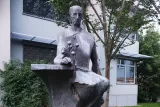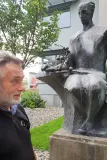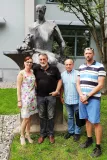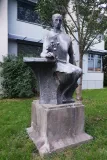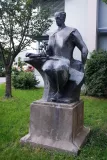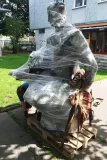Published: 02.04.2020
The metal sculpture of the Chemist, which has been located on Palackého street since 1978, will move to the Faculty of Chemical Technology, University of Pardubice. The owner of the sculpture will no longer be the city of Pardubice, but the oldest faculty of the University of Pardubice, which has received this work of art made by the academic sculptor Luboš Moravec from the municipality as a gift.
“The original location of the sculpture of the Chemist on Palackého street is no longer reasonable, especially after the Faculty of Chemical Technology, University of Pardubice moved from Čs. legií square to the university campus in Stavařov in 2009. By setting the sculpture in the new context close to the students of the faculty, it will regain its symbolism,” says Deputy Mayor Mgr. Jakub Rychtecký, adding that the main requirement for relocating the sculpture was placement in the public space.
Originally the sculpture of the sitting scientist with a molecule model in his right hand was on Palackého street in the place of the blind entrance to Havlíčkova street. The new location will be on Studentská street, specifically in front of the Dean’s Office, where it thematically belongs according to the Dean of the Faculty of Chemical Technology.
“We are extremely pleased that the city government decided to donate the sculpture to our institution on the occasion of an important anniversary of higher chemical education in Pardubice. This year we are celebrating 70 years, and this gift is a symbolic expression of mutual cooperation between the two parties. Pardubice is the city of chemistry, and the metal sculpture of the Chemist is a unique piece of art in the city and signifies the link to education in our city and region. The sculpture will undergo professional restoration in the studio of the artistic blacksmith Karel Bureš, who will treat and restore the entire surface. The Chemist – Atomic Scientist will be placed in a publicly accessible place in front of the Faculty in the university square, which is the imaginary heart of the whole university. The new stand of a cylindrical shape will be provided with a commemorative plaque reminding the friendship and cooperation between the city and the university. The unveiling of the sculpture is scheduled during of this year, according to the possibilities of social events and the representatives of the city will naturally be invited. This act will thus be a symbolic start of a series of events and celebrations of the 70th anniversary of higher chemical education in our city,” says Dean Prof. Petr Kalenda and explains the reasons behind his request for donation of this work of art into the ownership of the University of Pardubice.
“We have decided to donate the sculpture to the university also because the Faculty of Chemical Technology will pay the costs of the transportation and restoration, they have also paid for the new stand, and at the same time guarantee that they will provide for professional care for the unique work of art,” adds Deputy Rychtecký. At the moment the sculpture is stored by the university.
Luboš Moravec (1925 – 2010)
Academic sculptor Luboš Moravec was born April 10, 1925 in Dojetřice near Kutná Hora. From 1946 to 1953 he studied under the Czech sculptor and draftsman prof. Josef Wágner (a student of Jan Štursa) at AAAD in Prague, where he met his future wife Jana Moravcová - Modlová, later an art sculptor.He realized his works both in metal and in stone in his studio, an integral part of which was a large furnace. In cooperation with his wife, he created a completely new procedure for the final treatment of metal surfaces (patination, chasing), the so-called "metallization" technique, which is typical for his work. In his approaches he preferred large forms and simplified shapes. His artistic concepts are based on general human themes such as love, womanhood, motherhood, family and nature. During his time he has exhibited in many galleries in the Czech Republic and around the world, such as the National Gallery in Prague, the Regional Gallery in Hradec Králové, the galleries in Nuremberg, Stockholm, Oslo, Terezin, Munich, Berlin, Lisbon, London, Budapest and also in Beijing and Tokyo.
